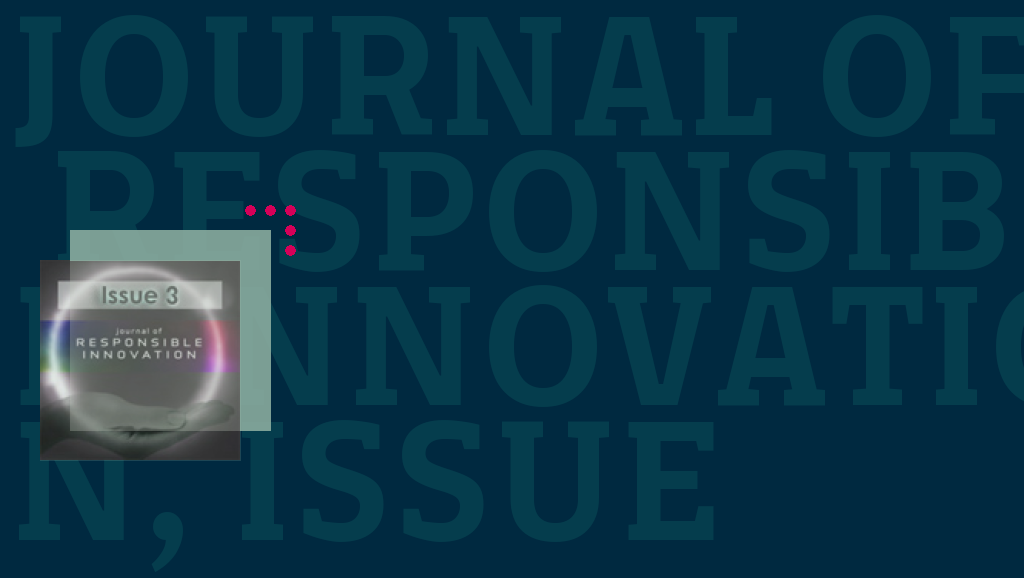Late last year the third issue of the first volume of the Journal of Responsible Innovation was published through Taylor and Francis. In this post we review the publication.
The journal opens with an editorial by Editor in Chief David Guston.
In Giving content to responsible innovation, Guston expresses his interest and excitement at the prospect of the responsible innovation community coming together through European sponsorship in the shape of the Horizon 2020 call for funding applications. He goes on to describe analogous but differently framed activities in the USA, describing similarities and differences in the two systems.
He talks about the dual responsibility that members of the community hold, those of firstly “taking the input from our natural science and engineering colleagues seriously”, and secondly for sketching out “a research program that represents the unique contributions that we as a community of social scientists can make”, while raising the issue of disagreement within the community of the larger purpose of RI research across the spectrum.
The Editorial concludes with an outline of the issue.
The first research article is Quality criteria and indicators for responsible research and innovation:
learning from transdisciplinarity, written by Fern Wickson and Anna L. Carewc.
In this article the authors describe the process of creating an evaluative rubric of performance indicators to address the challenge of articulating quality criteria and approaches to evaluate RRI. Through their experience of hosting a 2 day workshop designed with this purpose in mind, the authors first present the analysis criteria developed (through looking at common characteristics of RRI), before creating the rubric.
The process described is extremely interesting, and the rubric itself seems to make headway into the problem of how to measure RI in a comparative way. Possible results are described in a spider diagram, and issues of institutional and practical obstacles to carrying out an RI process are also addressed. The article concludes with a call to critique and develop the rubric further.
The issue continues with The hermeneutic side of responsible research and innovation by Armin Grunwald
In this article the author argues the need for a deeper analysis of the social construction of imagined futures and so-called “technofutures”. Grunwald argues that the social construction of their creation and diffusion may have effects upon public policy and societal opinion towards specific technologies, and therefore that a better understanding of their make-up would help in working towards the development of RI approaches.
Grunwald belies that such an approach could demystify techno-futures, and in particular help with understanding complexity issues, and that this is necessary for democratic debate to function in the present, regarding technological development and its processes.
The third and final research article of the issue is Embracing variety: introducing the inclusive modelling of (Parliamentary) technology assessment by Jurgen Ganzevlesa, Rinie van Estb and Michael Nentwich.
In this article, the authors introduce an inclusive way of modeling (parliamentary) technology assessment known as (P)TA. The article includes descriptions of different (P)TA organizations in europe, following, adapting and building upon the American Office of Technology Assessment model that existed between 1973 and 1995.
They describe 5 model types (while arguing that many others are possible) found across Europe, in the belief that their “more inclusive way of modeling (P)TA will be very helpful in classifying (P) TA functions in countries where parliamentary TA is not (yet) established. Accordingly, it may be used to map and discuss fruitful evolutionary pathways for (parliamentary) TA in countries and regions where (P)TA already exists or where the ambassadorship for (P)TA is about to take off”.
In their conclusion the authors spell out the importance for such modeling for the development of RI practices.
The issue then moves on into the Perspectives section.
In Responsible innovation and patent assertion entities, Thomas A. Hemphill explains the difference between Non Practicing Entity and patent assertion entity (PAE) behavior in relation to patent infringement claims and responsible innovation, before reviewing the economic impact of PAEs (often referred to as patent trolls) on the US economy. The author identifies market-based solutions to mitigate the impact of PAE litigation, and discusses the public policy benefits accruing to those embracing responsible innovation behaviour, while arguing against a proposed “loser pays” provision in legislation.
This short piece offers a fine statistical insight into the darker workings of US patent law.
The second Perspectives piece is New avenues within community engagement: addressing the ingenuity gap in our approach to health research and future provision of health care by Don Chalmers , Rebekah E. McWhirter , Dianne Nicol , Tess Whitton, Margaret Otlowski, Michael M. Burgess, Simon Foote, Christine Critchley and Joanne L. Dickinson.
In this article the authors describe their experience of working within a Public consultation project involving deliberative democracy. They recount a public consultation experience in Tasmania regarding the “biobank problem”, arguing that the use of such deliberative democracy is bringing an essential new dimension to public engagement in the genomic medicine era.
The Journal then contains two book reviews. Sujatha Raman reviews Responsible innovation: from concept to practice, by Xavier Pavie, Victor Scholten and Daphné Carthy, a book the reviewer describes as providing a business studies perspective on responsible innovation and what it might mean in practice to integrate the concept into organizations.
Justin Biddle reviews New frontiers in the philosophy of intellectual property, edited by Annabelle Lever, desribing it as a collection of high-quality papers that span many of the most important issues pertaining to IP and an excellent book.
Once again this issue offers broad and cutting edge opinion and papers, and is highly recommended to all of our readers. Articles can be downloaded through the link above.
——————
ALL THE REVIEWS of the Journal by Jonathan Hankins:
2014
Volume 1 part 1 / part 2 / part 3
2015
Volume 2 part 1 / part 2 & 3
2016
Volume 3 part 1 / part 2 / part 3
2017
Volume 4 part 1
—————-
















